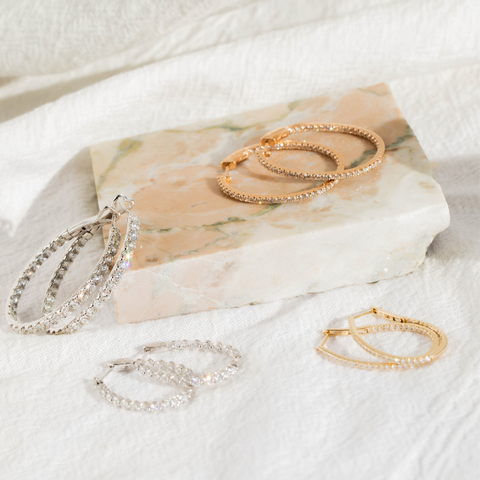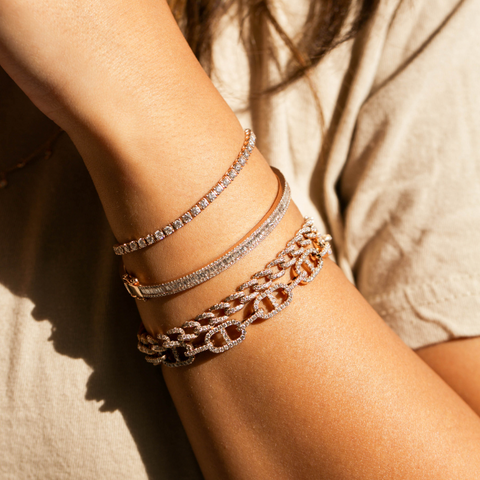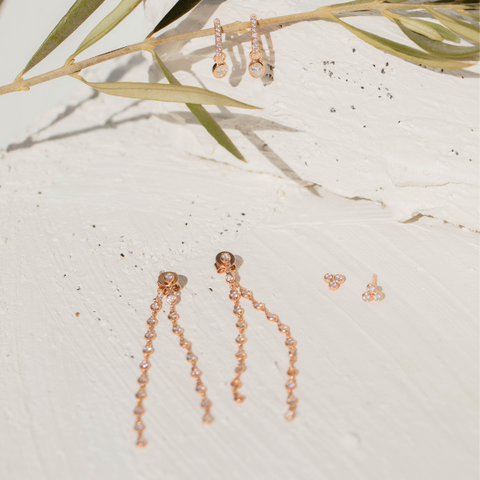Over time, things like dust, lotion, and your skin’s natural oils can start to build up on jewelry, causing it to look dull or dirty. Luckily, you can remove that build up with a simple at-home cleaning.
Learn how to restore your jewelry’s sparkle with this guide to cleaning fine jewelry at home. We’ll share the best method to clean most fine jewelry, go over how to clean specific materials, and include useful jewelry care tips.
How to Clean Most Fine Jewelry: Soap and Water Method

The best way to clean most fine jewelry at home is with the gentle soap and water method. This is the best method to clean solid gold jewelry, platinum jewelry, sterling silver jewelry, diamond jewelry, and most gemstone jewelry.
To use the soap and water cleaning method, you’ll need:
- A small bowl
- Warm water
- A soft toothbrush
- Mild dish soap
- A soft cloth
- A polishing cloth (optional)
Follow these five steps to clean your jewelry with the soap and water method:
- Make a Jewelry Cleaning Solution: Make a jewelry cleaning solution by filling a small bow with warm water, adding a few drops of dish soap, and mixing. Use lukewarm water, not hot water or cold water, because extreme temperatures can be too harsh for some jewelry materials. Use a gentle soap, like mild dish soap, to avoid exposing your jewelry to harsh chemicals. Avoid using moisturizing soap, which will leave a cloudy film behind on jewelry.
- Soak Your Jewelry: Place your jewelry in your cleaning solution and allow it to soak for around 30 minutes. Soaking your jewelry in warm, soapy water will help loosen up any caked-on dirt or grime.
- Gently Brush Your Jewelry: Remove your jewelry from your cleaning mixture and gently brush it with a soft-bristled toothbrush. If you don’t have a soft toothbrush, you can use any soft brush you have on hand.
- Rinse Your Jewelry: Rinse your jewelry in warm water. We recommend filling a clean bowl with warm water, then rinsing your jewelry in the bowl. Don’t rinse your jewelry over an open drain. If you want to rinse your jewelry under running water, be sure to plug the drain first.
- Dry Your Jewelry: Finally, dry off your jewelry with a soft cloth, such as a microfiber cloth. Don’t use paper towels, as they can be harsh enough to scratch more delicate materials. After your jewelry is dry, enhance its shine with a polishing cloth if desired.
Don’t Use Abrasive Materials or Harsh Chemicals

To avoid damaging your fine jewelry, don’t clean it with abrasive materials or harsh chemicals. Notably, many household cleaning products contain harsh materials that can scratch or destroy precious metals and certain gemstones. It’s especially important to avoid using cleaners containing bleach, ammonia, or chlorine, which can easily damage gold jewelry and most gemstones. Abrasive cleaners, including ones containing baking soda, are also far too harsh for gold and softer gemstones.
How to Clean Gemstone Jewelry at Home
Diamonds may be one of the hardest materials on earth, but many other gemstones are fairly fragile. With that said, the soap and water method we shared above is still gentle enough for most gemstones. That method gets your jewelry clean without exposing it to things that can harm more fragile gems, such as extreme temperatures, abrasive materials, harsh chemicals, or vibration.
However, the soap and water method shouldn’t be used for any type of jewelry that should not be submerged in water. This includes jewelry that features porous stones, like pearl jewelry and opal jewelry. It also includes any type of strung jewelry, as stringing materials can become weakened by water and trap moisture inside beads.
To clean jewelry that can’t be submerged in water, wipe it with a soft, dry, clean cloth. If needed, you can also dip a microfiber cloth into a soap and water solution, gently wipe the jewelry with the damp cloth, and immediately dry the jewelry.
Should You Use At-Home Ultrasonic Jewelry Cleaners?

Ultrasonic jewelry cleaners can clean jewelry thoroughly, which is why professional jewelers use them. However, ultrasonic cleaning can also easily damage jewelry, so we recommend being cautious about using at-home ultrasonic cleaners.
Many gemstones are far too fragile for ultrasonic cleaning, which involves vibration, pressure, and steam. Even tougher jewelry, like diamond jewelry, can be damaged by ultrasonic cleaning due to the vibration. This vibration can loosen settings, putting you at risk of losing your stones.
A professional will know exactly what can be cleaned in an ultrasonic cleaner and can inspect settings after cleaning to make sure stones are secure. That’s why, generally, we recommend leaving ultrasonic cleaning to professionals. You can still use an ultrasonic cleaner if you like, but be aware of the risks and be sure to keep an eye on your stone settings.
How Often Should You Clean Fine Jewelry at Home?
Everyday jewelry should be cleaned bi-weekly or as needed. Jewelry that’s prone to getting dirtier, such as stud earrings and everyday rings, may need to be cleaned more frequently. If you don’t wear a certain piece of jewelry often, simply clean it on an as-needed basis.
When Should You Get a Professional Cleaning?

In addition to cleaning your jewelry at home, you should occasionally have it cleaned by a jeweler. A professional jeweler can deep clean a piece of jewelry in a way that’s simply not possible with at-home methods. They can also inspect jewelry settings to ensure you’re not at risk of losing stones.
How often should you get a professional cleaning? Most jewelry should be professionally cleaned and inspected around once a year. Frequently worn pieces, like engagement rings and wedding bands, should be professionally cleaned and inspected every six months.
Final Thoughts
Still have questions about how to clean your fine jewelry at home? Contact our jewelry experts for personalized advice.
